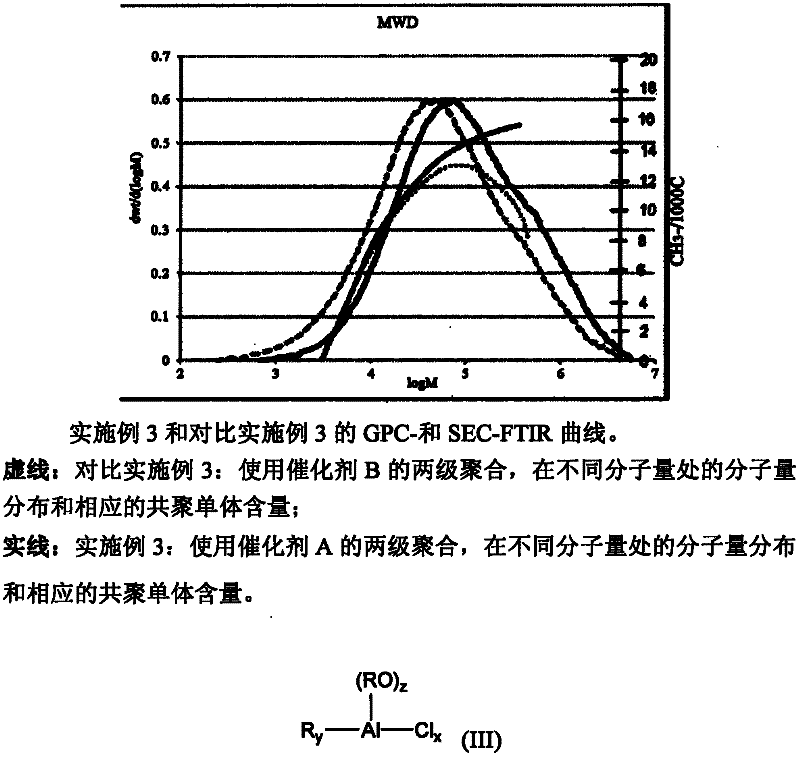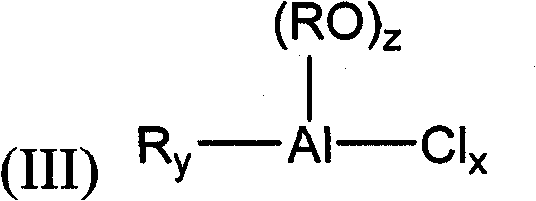Multistage process for the preparation of multimodal linear low density polyethylene
A linear low-density, polyethylene technology, applied in transportation and packaging, thin material processing, etc., can solve the problem of unseen adjustment of comonomer configuration, and achieve the effect of improving CCD
- Summary
- Abstract
- Description
- Claims
- Application Information
AI Technical Summary
Problems solved by technology
Method used
Image
Examples
Embodiment 1
[0240] Embodiment 1: the preparation of catalyst
[0241] a) Preparation of Mg-alcohol complex
[0242] Mg-alcoholates were prepared in large batches. Approximately 24 kg of Mg-alcohol complexes were prepared. By adding 16.0 kg (472 g Mg, 19.42 mol Mg) of (C 4 h 9 ) 1.5 Mg(C 8 h 17 ) 0.5 (BOMAG, 2.95% Mg) in 20% heptane to start the synthesis of Mg-alcohol complexes. To this solution was slowly added 4.92 kg (37.79 mol) of 2-ethyl-hexanol (EHA) at room temperature. The Mg / EHA molar ratio in this mixture was 1:1.945. The temperature was maintained at about room temperature, and the reactants interacted with each other for 108 minutes. 3.75 kg (52.1 mol) of n-pentane was added at room temperature to reduce the viscosity and stabilize the Mg-alcohol complex at 20-30° C. for 120 minutes. Thereafter, the temperature of the Mg-alcoholate solution returned to room temperature. Analysis showed that the Mg-alcohol complex had a Mg concentration of 2.4%.
[0243] b) MgCl 2...
Embodiment 2
[0249] Example 2: Slurry Polymerization
[0250] Polymerization of ethylene to produce LMW components (batch slurry polymerization)
[0251] A 5 liter autoclave reactor was used. 1300 g of propane was added to the reactor as a reaction medium. A hydrogen pressure of 27.3 bar was introduced into the reactor from a 560 ml feed vessel. The temperature of the reaction system was set at 85 °C, and the catalyst (prepared according to the above method) and the co-catalyst were fed into the reactor through two feed containers directly connected to the reactor head. Catalyst A was added to the upper feed vessel along with 3 ml of pentane. The cocatalyst (TIBA) was fed into the lower feed vessel at an Al / Ti molar ratio of 10 mol / mol. Catalyst and co-catalyst were fed into the reactor by an automatic feed system using a flow of propane. Polymerization was started by opening the ethylene feed line through the premix chamber. The target ethylene partial pressure is 3.5 bar. A pressu...
Embodiment 3
[0257] Example 3: Two-stage polymerization with catalyst A
[0258] a) First stage: Polymerization of ethylene to produce the LMW component (batch slurry polymerization):
[0259] A 5 liter autoclave reactor was used. 1300 g of propane was added to the reactor as a reaction medium. A hydrogen pressure of 27.4 bar was introduced into the reactor from a 560 ml feed vessel. The temperature of the reaction system was set at 85 °C, and the catalyst (prepared according to the above method) and the co-catalyst were fed into the reactor through two feed containers directly connected to the reactor head. About 40 mg of Catalyst A was added to the upper feed vessel along with 3 ml of pentane. The cocatalyst (TIBA) was fed into the lower feed vessel at an Al / Ti molar ratio of 10 mol / mol. Catalyst and co-catalyst were fed into the reactor by an automatic feed system using a flow of propane. Polymerization was started by opening the ethylene feed line through the premix chamber. The ...
PUM
| Property | Measurement | Unit |
|---|---|---|
| density | aaaaa | aaaaa |
| density | aaaaa | aaaaa |
| particle size | aaaaa | aaaaa |
Abstract
Description
Claims
Application Information
 Login to View More
Login to View More - R&D
- Intellectual Property
- Life Sciences
- Materials
- Tech Scout
- Unparalleled Data Quality
- Higher Quality Content
- 60% Fewer Hallucinations
Browse by: Latest US Patents, China's latest patents, Technical Efficacy Thesaurus, Application Domain, Technology Topic, Popular Technical Reports.
© 2025 PatSnap. All rights reserved.Legal|Privacy policy|Modern Slavery Act Transparency Statement|Sitemap|About US| Contact US: help@patsnap.com



